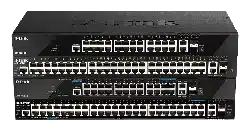Loading ...
Loading ...
Loading ...

DGS-1520 Series Gigabit Ethernet Smart Managed Switch Web UI Reference Guide
152
To view the following window, select the Dot1q Tunnel Port Settings tab, as shown below:
Figure 5-47 Dot1q Tunnel Settings (Dot1q Tunnel Port Settings) Window
The fields that can be configured are described below:
Parameter Description
Unit
Select the Switch unit ID that will be used here.
From Port - To Port
Select the port range that will be used here.
Trust Inner Priority
Select to enable or disable the 802.1Q Inner Trust Priority feature here. When the
trusting priority option is enabled on an 802.1Q tunnel port, the priority of the VLAN
tag in the received packets will be copied to the service VLAN tag.
Miss Drop
Select to enable or disable the Miss Drop feature here. If the VLAN mapping Miss
Drop option is enabled on the receiving port, when the original VLAN of the
received packets cannot match the VLAN mapping entries or rules on this port, the
received packets will be dropped.
Insert Dot1q Tag
Enter the 802.1Q VLAN ID that is inserted to the untagged packets, which are
received, on the 802.1Q tunnel port(s) here. The range is from 1 to 4094.
VLAN Mapping Profile
Enter the ID of the VLAN mapping profile here. A lower ID has a higher priority.
The ID range is from 1 to 4.
Action Select Add to add a new entry based in the information entered.
Select Remove to remove an entry based in the information entered.
Click the Apply button to accept the changes made.
VLAN Mapping
This window is used to display and configure the VLAN mapping settings. If a profile is applied on an interface, the
Switch matches the incoming packets according to the rules of the profile. If the packet matches a rule, the action of
the rule will be taken. This action may be adding or replacing the outer-VID, specifying the priority of the new outer-
TAG or specifying the packet's new inner-VID.
Loading ...
Loading ...
Loading ...
